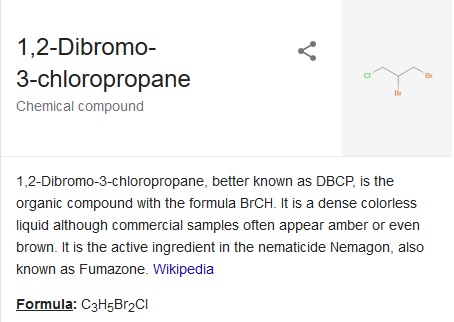
What is 1,2-Dibromo-3-chloropropane?
1,2-Dibromo-3-chloropropane is also known as DBCP, the formula that describes it is BrCH(CH2Br)(CH2Cl.
DBCP is a dense liquid with no color and a strong odor.
When we talk about its color, sometimes it can appear as amber, yellow or brown.
It is used as a soil fumigant, nematocide and to make other chemicals.
Until 1977, it was used on over 40 different crops in the United States.
It fought pests that attacked the roots of fruit trees.
What is the common name of 1,2-Dibromo-3-chloropropane?
1,2-Dibromo-3-chloropropane is also known as DBCP.
Is 1,2-Dibromo-3-chloropropane harmful?
Yes, DBCP was classified as Potentially Carcinogenic.
It can cause permanent reproductive damage, irritation on skin and eyes, breathing can cause irritation on the nose and throat, leading to coughing and wheezing.
Headache, nausea, vomiting, weakness, lightheartedness, passing out and even death.
Repeated exposure can damage the eyes and cause lesions of the skin.
The liver and kidneys can be damaged as well.
1,2-Dibromo-3-chloropropane Contamination
DBCP is expected to volatilize from surface water. It is highly persistent in soil and has been shown to remain there for more than 2 years. It is mobile in soil and may migrate to groundwater.
It can contaminate humans and animals trough the air, water in drinking wells that DBCP was used within the previous 2 years or wells not used for drinking water.
And also in food more specific vegetables that were grown in soils treated with it.
When was 1,2-Dibromo-3-chloropropane banned?
DBCP was banned in 1979 after its harmful effects was discovered, the initiative came from the EPA (United States Environmental Protection Agency).

